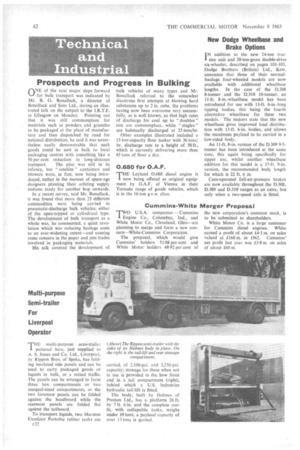Prospects and Progress in Bulking
Page 66

If you've noticed an error in this article please click here to report it so we can fix it.
(NE of the next major steps forward kJ for bulk transport was indicated by Mr. B. G. Bonallack, a director of Bonallack and Sons Ltd., during an illustrated talk on the subject to the 1.R.T.E. in Glasgow on Monday. Pointing out that it was _still commonplace for materials such as powders and granules to be packaged at the place of manufacture and then dispatched by road for national distribution, he said it was nevertheless easily demonstrable that such goods could be sent in bulk to local packaging centres with something like a 50 per cent reduction in long-distance transport. The plan was still in its infancy, but " satellite " containers and blowers were, in fact, now being introduced, rather in the manner of space-age designers planting their orbiting supply stations ready for another hop onwards.
In a recent survey, said Mr. Bonallack, it was found that more than 25 different commodities were being carried -in pneumatic-discharge bulk vehicles, either of the open-topped or cylindrical type, The development of bulk transport as a whole was, he commented, a quiet revolution which was reducing haulage costs to an ever-widening extent—and causing some concern in the paper and jute trades involved in packaging materials.
His talk covered the development of bulk vehicles of many types and Mr. Bonallack referred to the somewhat disastrous first attempts at blowing hard substances up to 2 in. cube, the problems having now been overcome very successfully, as is well known, so that high rates of discharge for coal up to " doubles " size are commonplace, while " singles " are habitually discharged at 25 tons/hr.
Other examples illustrated included a 15-ton-capacity flour tanker with 36 tons/ hr. discharge rate to a height of 50 ft., which is currently delivering more than 45 tons of flour a day.
0.680 for 0.A.F.
THE Leyland 0.680 diesel engine is I now being offered as original equipment by O.A.F. of Vienna in their Tornado range of goods vehicles, which is in the 16-ton g.v.w. class.














































































































































































































































